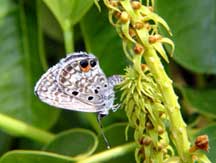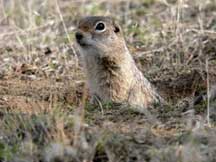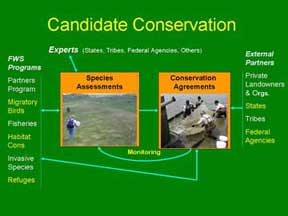|
|
Candidate Conservation Program Vision 

Miami Blue Butterfly, photo by H.L. Salvato |
Working in partnership with public and private landowners, the Candidate Conservation Program assesses species and develops and facilitates the use of voluntary conservation tools for collaborative conservation of candidate and other species-at-risk and their habitats, so that these species do not need the protection of the Endangered Species Act. |

Washington Ground Squirrel, photo by J. Delavan
|
| Program Overview |
The Candidate Conservation Program uniquely bridges the non-regulatory and regulatory approaches to species conservation. Two key elements:
- Conducting assessments to identify species most in need of the ESA’s protection.
- Working through partnerships to conserve these species by improving habitat and removing threats.

Species Assessments – Identify candidates for listing and provides conservation recommendations that can remove and reduce threats so that listing them will be unnecessary.
- Process emphasizes coordination with States to obtain the best available information on species status and recommendations for conservation.
- Provides the foundation for planning and implementing voluntary conservation efforts that are most likely to be effective in making listing unnecessary.
Cooperative Conservation – Through a broad suite of public and private partners, provide technical assistance and leverage funding for conservation of candidate and other at-risk species.
- Provide information to guide strategic approaches to ensure voluntary efforts occur where they are most needed and most likely to be effective in making listing unnecessary.
- Facilitate development and implementation of Candidate Conservation Agreements and Candidate Conservation Agreements with Assurances.
- Leverage resources by facilitating funding for landowners to engage in voluntary conservation (e.g. through various FWS grants and agreements, Farm Bill programs, DOD progams).
|
| Candidate Conservation Agreements |
| Two types of agreements have been developed to formulate action plans that address the conservation of candidate and other species at-risk as well as the concerns of the agencies and landowners who manage the lands supporting habitat for these species. more » |
|
|
| Candidate Assessment |
| Through our candidate assessment process, we use the best scientific and commercial data to determine whether a species ought to be listed, based on the listing factors in section 4 of the ESA.
The assessment also provides key information for conservation planning.
more » |
| Candidate Notice of Review |
Published on December 6, 2007, the most recent candidate notice of review identified 280 species that are candidates for listing under the Endangered Species Act. more » |
| Conservation Tools for Candidate and Species at-risk |
We work with private landowners, other Federal and State agencies, including other programs within the Fish and Wildlife Service, and Tribes to forge voluntary conservation agreements that benefit candidate and other species at-risk. We provide technical assistance on designing and implementing conservation actions to address threats identified in our species assessments.
|
| State Wildlife Action Plans |
All State and Territorial fish and wildlife agencies have established comprehensive conservation plans that, together, provide a nationwide blueprint of actions to conserve imperiled species. Most, if not all, of our candidate species are included in these plans. Working together with the states we may be able to remove threats and improve habitats and prevent them from becoming threatened of endangered.
The State Wildlife Action Plans are a through state-by-state assessment of the condition/status of wildlife and the actions needed to ensure their survival. Individual State Wildlife Action Plans can be found at www.wildlifeactionplans.org.
|
|
|
|
Last updated:
January 25, 2008
